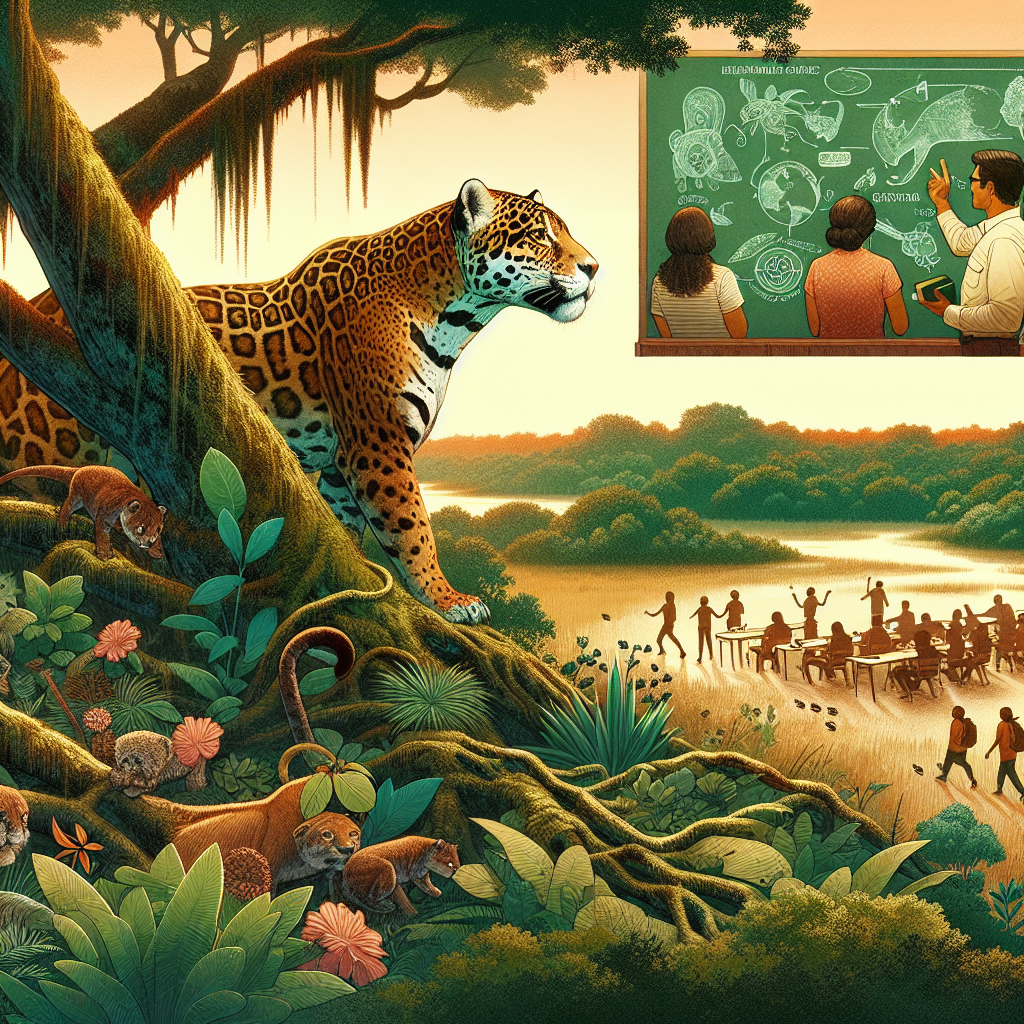The Role of Jaguars in Ecosystems: Community Education in Tulum
Understanding Jaguars: Apex Predators
Jaguars (Panthera onca) are one of the most iconic and powerful predators in the American rainforest. As apex predators, they play a critical role in maintaining the balance of their ecosystems. These magnificent creatures are primarily found in tropical and subtropical rainforests, including Central and South America. Their presence influences the population dynamics of other species and the overall health of their habitat.
Physical Characteristics and Behavior
Jaguars are known for their distinctive coat, characterized by a yellowish-orange color adorned with black rosettes. This coloration not only aids in camouflage but also serves as a mark of their identity. Measuring up to 6 feet in length and weighing between 100 to 250 pounds, jaguars are the third-largest cat species in the world. They are solitary animals, primarily active during dusk and dawn (crepuscular), which reduces competition for food.
Ecological Significance of Jaguars
Jaguars serve as keystone species in their ecosystems, meaning their presence has a disproportionately large effect on their environment compared to their biomass. By preying on herbivores, they help regulate these populations, preventing overgrazing and promoting plant biodiversity. Their hunting behavior also ensures that weaker individuals within prey species’ populations are removed, which contributes to healthier gene pools.
Influence on Biodiversity
Through their predatory habits, jaguars indirectly affect many different species within their ecosystem. For instance, by controlling the populations of lower trophic level species, such as deer and peccaries, they allow for the flourishing of various plant species, which serves as a habitat for other animals. This dynamic is crucial for maintaining biodiversity, as diverse ecosystems are more resilient to environmental changes.
Community Education Initiatives in Tulum
In Tulum, Mexico, organizations and local communities have acknowledged the necessity of protecting jaguars and their habitats through education. With Tulum being part of the larger Riviera Maya region, rich in biodiversity, there’s a vital need to engage local communities in conservation efforts.
Importance of Local Engagement
Local communities play a pivotal role in jaguar conservation. Engaging residents facilitates the gathering of indigenous knowledge and fosters pride in their natural heritage. In Tulum, programs aim to educate the community about the ecological significance of jaguars and the threats they face.
Workshops and Guided Tours
Various NGOs and conservationists conduct workshops that incorporate indigenous storytelling, science, and practical conservation techniques. Educative tours through jungles that highlight jaguar habitats allow participants to learn about the importance of these animals firsthand. Such excursions integrate environmental education with economic opportunity, as responsible ecotourism evolves, benefiting local communities.
School Programs and Curricula
Local schools have embraced curricula that emphasize wildlife conservation. By including lessons on jaguars’ roles in ecosystems, these educational programs enhance students’ understanding of biodiversity. Activities like art competitions featuring jaguars or field trips to nearby reserves not only make learning engaging but also encourage children to become advocates for wildlife conservation.
Collaborative Conservation Efforts
Various organizations collaborate on conservation efforts to protect jaguar populations and their habitats. For instance, the Tulum-based organization “Cuerpo de Conservación del Jaguar” aims to develop partnerships to preserve significant habitats, such as the Selva Maya, which is critical for jaguar conservation.
Technology in Conservation
Utilizing technology plays an essential role in conservation strategies, such as camera trapping, which gathers data on jaguar populations and their movement patterns. By creating a more profound understanding through technology, conservationists can implement strategies for habitat protection and connectivity.
The Impact of Deforestation and Threats
Deforestation presents a significant risk to jaguar populations, particularly in regions like Tulum, where urban expansion and tourism have increased. The fragmentation of their habitat limits their hunting grounds and pushes them into closer contact with humans, leading to conflicts.
Establishing Wildlife Corridors
Creating wildlife corridors is one initiative gaining traction in jaguar conservation. These corridors link fragmented habitats, allowing jaguars to roam freely while maintaining genetic diversity among populations. By educating local communities about their importance, these initiatives garner public support and create awareness about sustainable practices.
Promoting Sustainable Practices
Encouraging sustainable agricultural practices is crucial in Tulum to mitigate habitat loss. Educating farmers on environmentally friendly techniques can reduce deforestation and promote coexistence with local wildlife. Through community workshops, farmers learn about organic farming, agroforestry, and permaculture, benefiting both their livelihoods and wildlife preservation.
Local Economic Incentives
Another aspect of education focuses on raising awareness of the economic benefits of conservation. By recognizing the potential revenue from ecotourism, communities are incentivized to preserve the natural environment. Educational initiatives that highlight the financial gain from maintaining healthy ecosystems can shift perceptions towards conservation.
Advocacy and Policy Change
Local engagement is essential not only at the grassroots level but also in influencing policy change. Community leaders are encouraged to advocate for stronger legal protections for jaguar habitats. Education programs guide residents in understanding conservation laws and the importance of their participation in policy-making.
Culture and Jaguars
In the local Mayan culture, jaguars have deep spiritual significance. Integrating cultural narratives about jaguars into educational programs fosters a stronger connection among community members to their heritage and the natural world. By emphasizing the cultural importance of jaguars, conservation efforts become more relatable and compelling.
Conclusion
The need for continuous community education around the role of jaguars in ecosystems is more critical than ever. In Tulum, fostering awareness and inspiring action can lead to successful conservation initiatives. By empowering local communities through education, Tulum can become a beacon for jaguar conservation and biodiversity, encouraging a harmonious relationship between people and nature.
Jaguars are not just a symbol of beauty but also essential to the intricate web of life in their ecosystems. Collaborative efforts, informed by science, culture, and local knowledge, will ensure that these magnificent creatures continue to roam the landscapes of Tulum for generations to come.







